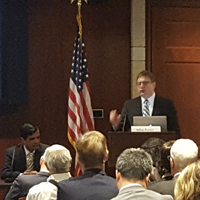A National Research Agenda for Intelligent Infrastructure
The Computing Community Consortium (CCC) in collaboration with the Electrical and Computer Engineering Department Heads Association (ECEDHA) recently released eight white papers describing a collective research agenda for intelligent infrastructure. These papers draw from a large network of expertise including CCC Council members, former CCC Council members, CRA Board members, and other members of the academic and industry communities for a total of 40 different authors from 27 different institutions.
We will be blogging about each paper over the next few weeks. We start with the overview paper: A National Research Agenda for Intelligent Infrastructure.
Our infrastructure touches the day-to-day life of each of our fellow citizens, and its health is crucial to the overall competitiveness and prosperity of our country. Unfortunately, the current state of U.S. infrastructure is not good. The American Society of Civil Engineers’ latest report on America’s infrastructure ranked it at a D+, stating that it is in need of $3.9 trillion in new investments. This dire situation constrains the growth of our economy, threatens our quality of life, and puts our global leadership at risk.
Intelligent infrastructure is the deep embedding of sensing, computing, and communications capabilities into traditional urban and rural physical infrastructures such as roads, buildings, and bridges to increase efficiency, resiliency, and safety. It provides capabilities that are:
- Descriptive: Provides an accurate and timely characterization of current state, e.g., water level in a storm drain or traffic congestion.
- Prescriptive: Recommends immediate and near-term actions, e.g., re-routing traffic or dispatching onsite service personnel.
- Predictive: Anticipate future challenges and opportunities, based on assessment of the current state, patterns of past activity and available resources and capabilities, e.g., street-level flooding by incorporating water sensors, weather patterns and runoff capabilities.
- Proactive: Guides complex decision making and scenario planning, incorporating economic data, to inform future investment.
Across disciplines ranging from engineering to computer science to public policy, intelligent infrastructure is increasingly seen as a solution to the long-standing problems that face local governments attempting to respond to both long term and short term threats to resilience: 1) strained resources spread across ever growing urban populations, 2) aging infrastructures and public services systems, 3) competitiveness in the global economy, and 4) acute human and environmental stressors due to rapid growth and change in regional areas.
How to design and deploy intelligent infrastructure to efficiently and effectively support our communities is one of the central questions going forward for the US. In this series of white papers, we looked at the potential of intelligent infrastructure across many domains including transportation, city services, energy, public safety and disaster response. We also examine the needs of rural communities for intelligent infrastructure and overarching safety and security challenges.
| Descriptive | Prescriptive | Predictive | Proactive | |
| Intelligent Transportation | Real time traffic congestion information
|
Reroute traffic; Adjust dynamic lane configuration (direction, HOV)
|
Anticipate rush hour / large event congestion; Anticipate weather related accidents | Suggest traffic patterns w/ intelligent stoplights; road diet plan |
| Intelligent Energy Management | Real time energy demand information | Improve asset utilization and management across transmission and distribution system | Anticipate demand response required to ensure grid reliability
|
Suggest new market approaches to integrate production and distribution capabilities |
| Intelligent Public Safety and Security | Real time crowd analysis | Threat detection; Dispatch public safety officers | Anticipate vulnerable settings and events | Suggest new communication and coordination response approaches |
| Intelligent Disaster Response | Real time water levels in flood prone areas | Timely levee management and evacuations as needed | Anticipate flood inundation with low-cost digital terrain maps | Inform National Flood Insurance Program; Inform vulnerable populations |
| Intelligent City Systems | Describe mobility patterns (pedestrian, cycling, automobile, trucking, electric and autonomous vehicles) | Adjust mobility management to improve safety; reduce energy usage | Anticipate changing needs for parking, charging stations, bike and ride share programs. | Inform future mobility capabilities to drive economic development and reduce barriers to employment |
| Intelligent Agriculture | Characterize spatial and temporal variability in soil, crop, and weather. | Advise based on environmental stressors and crop traits | Forecast crop yield; Anticipate seasonal water needs | Customize management practices and seed selection to local conditions |
| Rural Communities | Describe rural communities (skew towards aging adults) | Make sure rural Americans are not left behind in digital revolution | Anticipate rural population growth | Proposed Rural-focused Intelligent Infrastructure Act |
Three additional papers will be coming out soon on the respective agendas for Wireless Technologies, Intelligent Health, and Privacy for Intelligent infrastructure. See all the intelligent infrastructure white papers here.










